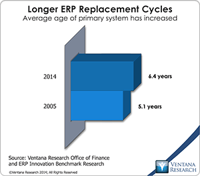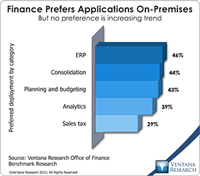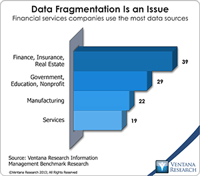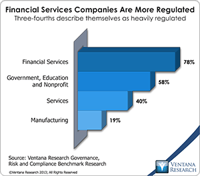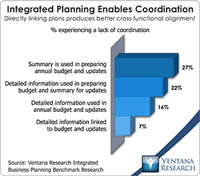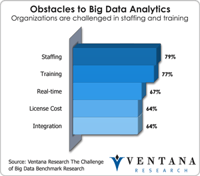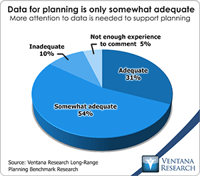IBM’s THINK conference, just held this February in San Francisco, is IBM's annual user conference. THINK is designed to showcase upcoming product updates and releases from IBM, along with provide best practices on a wide range of topics. While many technologies were on display, there is one topic in particular I wanted to cover this year: Blockchain.
Read More
Topics:
Office of Finance,
IBM,
Financial Performance Management,
FPM,
Digital Technology,
blockchain
Workday Financial Management (which belongs in the broader ERP software category) appears to be gaining traction in the market, having matured sufficiently to be attractive to a large audience of buyers. It was built from the ground up as a cloud application. While that gives it the advantage of a fresh approach to structuring its data and process models for the cloud, the product has had to catch up to its rivals in functionality. The company’s ERP offering has matured considerably over the...
Read More
Topics:
Microsoft,
SAP,
ERP,
FP&A,
NetSuite,
Office of Finance,
Operational Performance Management (OPM),
Reporting,
close,
closing,
Controller,
dashboard,
Human Capital,
Reconciliation,
Tax,
Analytics,
Business Intelligence,
Cloud Computing,
Collaboration,
IBM,
Oracle,
Uncategorized,
Business Performance Management (BPM),
CFO,
Data,
finance,
Financial Performance Management (FPM),
Financial Performance Management,
FPM,
Intacct
The enterprise resource planning (ERP) system is a pillar of nearly every company’s record-keeping and management of business processes. It is essential to the smooth functioning of the accounting and finance functions. In manufacturing and distribution, ERP also can help plan and manage inventory and logistics. Some companies use it to handle human resources functions such as tracking employees, payroll and related costs. Yet despite their ubiquity, ERP systems have evolved little since their...
Read More
Topics:
Big Data,
Microsoft,
SAP,
Social Media,
ERP,
FP&A,
Mobile Technology,
NetSuite,
Office of Finance,
Operational Performance Management (OPM),
Reporting,
close,
closing,
Controller,
dashboard,
Human Capital,
Reconciliation,
Analytics,
Business Intelligence,
Cloud Computing,
Collaboration,
IBM,
Oracle,
Uncategorized,
Business Performance Management (BPM),
CFO,
Data,
finance,
Financial Performance Management (FPM),
Supply Chain Performance Management (SCPM),
Financial Performance Management,
FPM,
Intacct
Whatever Oracle’s cloud strategy had been the past, this year’s OpenWorld conference and trade show made it clear that the company is now all in. In his keynote address, co-CEO Mark Hurd presented predictions for the world of information technology in 2025, when the cloud will be central to companies’ IT environments. While his forecast that two (unnamed) companies will account for 80 percent of the cloud software market 10 years from now is highly improbable, it’s likely that there will be...
Read More
Topics:
Microsoft,
Predictive Analytics,
SAP,
ERP,
FP&A,
Mobile Technology,
NetSuite,
Office of Finance,
Operational Performance Management (OPM),
Reporting,
close,
closing,
Controller,
dashboard,
Human Capital,
Tax,
Analytics,
Business Collaboration,
Business Intelligence,
Cloud Computing,
Collaboration,
IBM,
Oracle,
Business Performance Management (BPM),
CFO,
Customer Performance Management (CPM),
Data,
finance,
Financial Performance Management (FPM),
Sales Performance Management (SPM),
Supply Chain Performance Management (SCPM),
Financial Performance Management,
FPM,
Intacct,
Spreadsheets
The developed world has an embarrassment of riches when it comes to information technology. Individuals walk around with far more computing power and data storage in their pockets than was required to send men to the moon. People routinely hold on their laps what would have been considered a supercomputer a generation ago. There is a wealth of information available on the Web. And the costs of these information assets are a tiny fraction of what they were decades ago. Consumer products have...
Read More
Topics:
Big Data,
Mobile,
Predictive Analytics,
Social Media,
Customer Experience,
Operational Performance Management (OPM),
Performance,
Analytics,
Business Analytics,
Business Collaboration,
IBM,
Business Performance Management (BPM),
Customer Performance Management (CPM),
finance,
Financial Performance Management (FPM),
Sales Performance Management,
Sales Performance Management (SPM),
Social,
Financial Performance Management,
SPSS
The proliferation of chief “something” officer (CxO) titles over the past decades recognizes that there’s value in having a single individual focused on a specific critical problem. A CxO position can be strategic or it can be the ultimate middle management role, with far more responsibilities than authority. Many of those handed such a title find that it’s the latter. This may be because the organization that created the title is unwilling to invest the necessary powers and portfolio of...
Read More
Topics:
GRC,
Office of Finance,
Operational Performance Management (OPM),
Chief Risk Officer,
CRO,
ERM,
OpenPages,
Business Analytics,
Business Collaboration,
Cloud Computing,
Data Governance,
IBM,
Business Performance Management (BPM),
compliance,
Data,
Financial Performance Management (FPM),
Risk,
Financial Services,
FPM
Integrated risk management (IRM) was a major theme at IBM’s recent Smarter Risk Management analyst summit in London. In the market context, IBM sees this topic as a means to differentiate its product and messaging from those of its competitors. IRM includes cloud-based offerings in operational risk analytics, IT risk analytics and financial crimes management designed for financial institutions and draws on component elements of software that IBM acquired over the past five years, notably from ...
Read More
Topics:
GRC,
Office of Finance,
Operational Performance Management (OPM),
Chief Risk Officer,
CRO,
ERM,
OpenPages,
Business Analytics,
Business Collaboration,
Cloud Computing,
Data Governance,
Governance, Risk & Compliance (GRC),
IBM,
Business Performance Management (BPM),
compliance,
Customer Performance Management (CPM),
Data,
Information Applications (IA),
Information Management (IM),
IT Performance Management (ITPM),
Risk,
Supply Chain Performance Management (SCPM),
Financial Services,
FPM
IBM’s Big Data and Analytics Analyst Insights conference started me thinking about the longer-term potential impact of big data and related technologies on business management. I covered some of the near-term uses of big data and analytics in an earlier perspective. There are numerous uses of big data that can provide incremental improvements to existing processes and practices. Some of these will have a significant impact on changing business models, enabling new classes of products and...
Read More
Topics:
Big Data,
Planning,
Predictive Analytics,
Operational Performance Management (OPM),
Management,
Budgeting,
Analytics,
Business Analytics,
Business Collaboration,
IBM,
Business Performance Management (BPM),
Financial Performance Management (FPM),
Information Management (IM),
decision,
FPM,
Watson
IBM hosted the Big Data and Analytics Analyst Insights conference in Toronto recently to emphasize the strategic importance of this topic to the company and to highlight recent and forthcoming advancements in its big data and analytics software. Our firm followed the presentations with interest. My colleagues Mark Smith and Tony Cosentino have commented on IBM’s execution of its big data strategy and its approach to analytics. As well, Ventana Research has conducted benchmark research on ...
Read More
Topics:
Big Data,
Office of Finance,
Operational Performance Management (OPM),
MRO,
Analytics,
Business Analytics,
Business Intelligence,
IBM,
Operational Intelligence,
Business Performance Management (BPM),
Customer Performance Management (CPM),
Financial Performance Management (FPM),
Sales Performance Management (SPM),
FPM,
Maximo,
TM1,
Watson
I recently attended Vision 2013, IBM’s annual conference for users of its financial governance, risk management and sales performance management software. These three groups have little in common operationally, but they share software infrastructure needs and basic supporting software components such as reporting and analytics. Moreover, while some other major vendors’ user group meetings concentrate on IT departments, Vision focuses on business users and their needs, which is a welcome...
Read More
Topics:
Planning,
Reporting,
Budgeting,
closing,
XBRL,
Analytics,
Data Management,
IBM,
Business Performance Management (BPM),
CFO,
Financial Performance Management (FPM),
Financial Performance Management,
FPM,
SEC,
TM1,
Digital Technology




